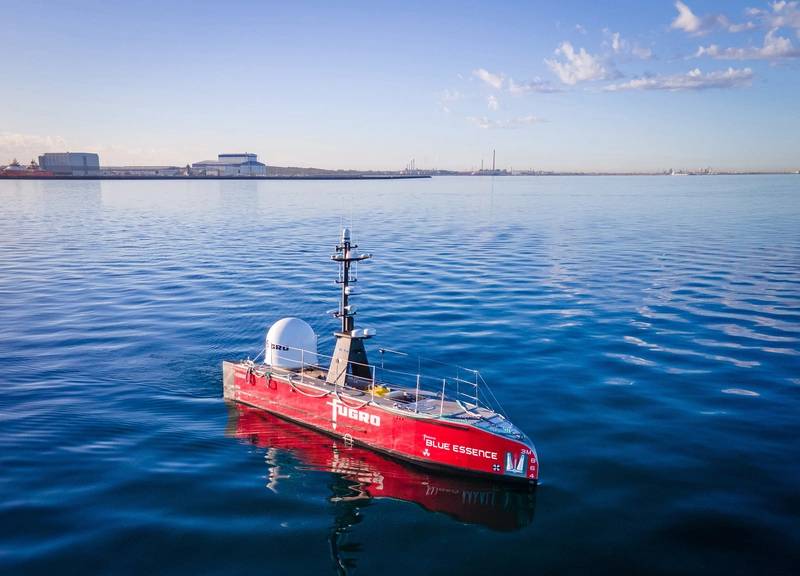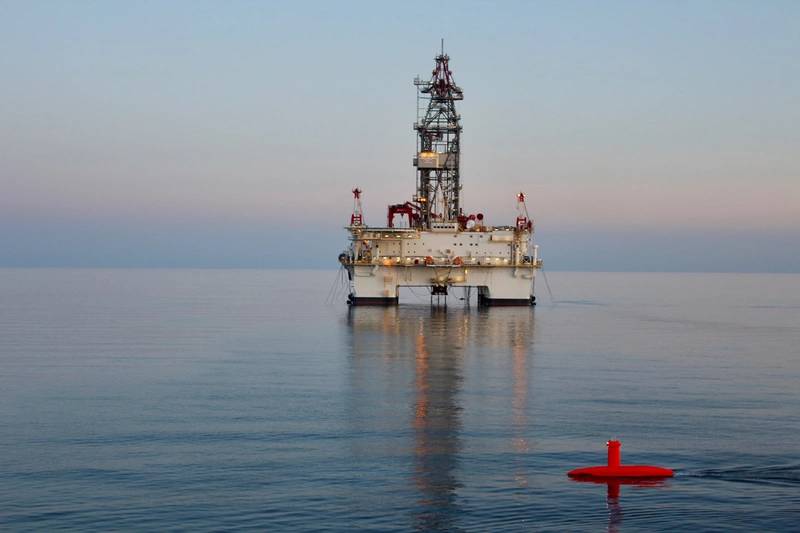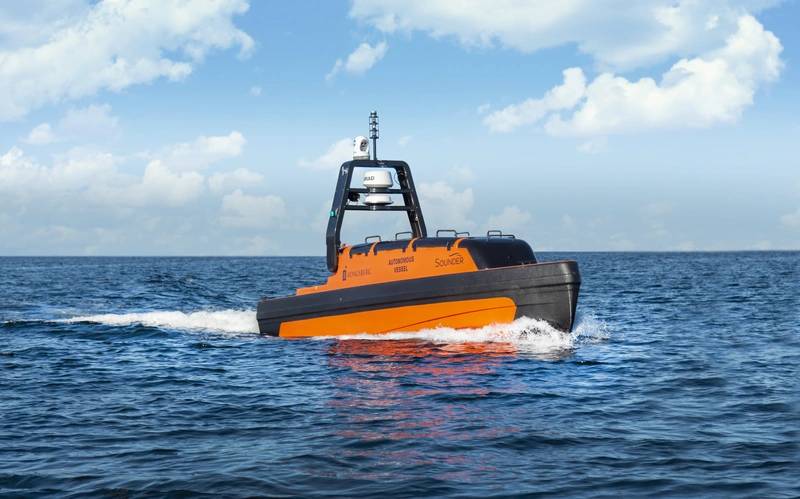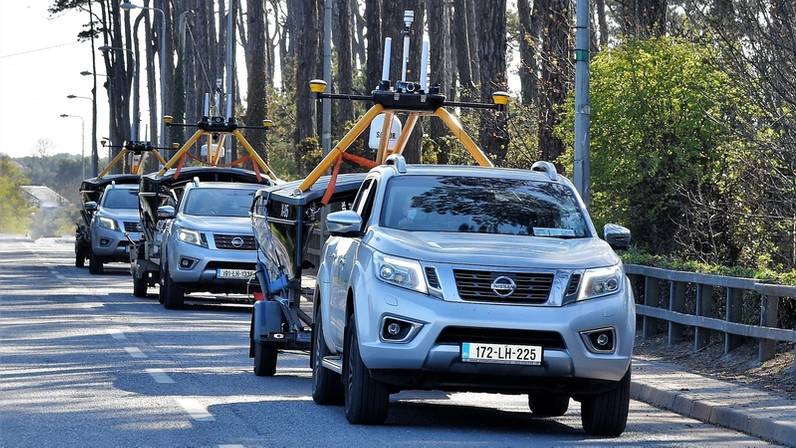Need a Survey? There’s a USV for That
While the adoption of unmanned/uncrewed surfaces vessels (USVs) was initially in defence, use of these low footprint systems has spread into other sectors, not least survey, and now the race is on for greater capability, endurance and autonomy. Elaine Maslin reports.
After starting small, in inland waterways, use of USVs for survey operations has moved into coastal and now offshore waters. Given the extensive amount of seabed and rapid growth in offshore wind, there’s plenty of work out there for them to do.
With the travel restrictions posed by Covid and increasing awareness of climate change, the incentives to use them have only increased.
“We are seeing a strong drive for USVs to become mainstream,” says XOCEAN’s CEO James Ives. “USVs offer three key benefits; safety – no people required to go offshore; environment – our USVs emit 1,000 times less carbon emissions than a conventional survey ship; and economics – USVs can deliver the same data, at a lower cost.”
“USVs consume up to 95% less fuel than traditional, crewed vessels, supporting international ambitions for net zero global emissions in the marine industry,” says Ben Simpson, CEO as USV manufacturer SEA-KIT.
“The decrease in at-sea man-hours, reduced operator workloads, increased efficiency, along with extended endurance, and decreased carbon footprint, have also provided significant risk reduction and environmental benefits,” adds Rick Williams, Director, Unmanned Surface and Subsurface systems in the Maritime Sector, at L3Harris.
The trajectory is clear. Ivar de Josselin de Jong, director of remote inspection at Fugro, thinks that in the next decade, there will be more uncrewed operations than crewed operations. “That whole business will look completely different,” he says. “An offshore survey vessel has 30-50 people on board. We’re moving to solutions where we have all personnel working in the safe onshore environment, with HSE and CO2 footprint reduction. It’s super exciting.”
 Fugro's Blue Essence. Image courtesy Fugro
Fugro's Blue Essence. Image courtesy Fugro
Fugro
Fugro started working on USVs 6-7 years ago, says de Jong, with the goal to make operations more effective and more efficient. One of the first initiatives was a 2m-long prototype with an MBES and remote-control capabilities for inland waters. Fugro also converted a small survey boat to uncrewed for cable landing surveys and shallow water activities. Seabed mapping followed, in partnership with ASV Global Ltd., now L3 Harris ASV, with whom Fugro developed its 9m-long diesel-powered Blue Shadow vessel, equipped with an EM 2040 MBES and “developed to provide a high-speed hydrography solution,” says de Jong. Fugro envisions multiple Blue Shadows operating as force multipliers from a parent vessel – covering more area without additional people offshore.
Part of that development meant developing an adaptive line planning system, which recognises the data and water depth and then automatically applies the right line spacing in the survey programme to comply with whatever the level of quality of data is required for any specific job.
“These units are operational and we are delivering two large survey scopes in Australia for the Australian Hydrographic Office,” says de Jong. The first was a 1,000sq km survey in the Gulf of St Vincent the second was in the Torres Strait in northern Queensland covering 1,200sq km. Over four months (starting May) another survey is being done north of Broome. Both have seen a parent vessel and USV deployed from that vessel, using a dedicated LARS, performing survey operations, as part of Australia’s HydroScheme Industry Partnership Program (HIPP).
Meanwhile, the first of Fugro’s 12m, SEA-KIT-built Blue Essence hybrid USVs, which come with a Blue Volta eROV, have also gone into operation on pipeline inspection work off Australia. The second is scheduled for delivery to Fugro in Aberdeen in June this year. Designed for up to 30 days operation, supporting regular survey operations, or ROV inspection for up to 10 days, these vessels are operated beyond visual line of site. A bigger 24m vessel is coming, which will have similar survey capabilities, as well as geotechnical investigation capabilities. The goal is to cover the whole marine site investigation and marine asset integrity business scope, says de Jong.
 DriX off the coast of Bakou. Image courtesy iXblue
DriX off the coast of Bakou. Image courtesy iXblue
DriX
iXblue launched its diesel-powered 7.7m DriX USV, designed for seakeeping, stability and low noise, in 2017. On a survey mission, working at 8kts, it can run for five days, before needing to be recovered, refuelled, inspected and relaunched – itself just a three-hour exercise, says Guillaume Eudeline, USV and boats Business Development Manager at iXblue.
About 10 DriXs have been sold to date, including one to the US’ National Oceanic and Atmospheric Administration (NOAA) and organisations in South Korea and Australia. They’re mostly being used for traditional survey/seabed mapping, which DriX’s stable submarine-shaped form and payload gondola supports. But it’s also done pipeline/cable inspection, positioning of beacons and positioning and communications with an AUV in 1,000m water depth and it can carry a wide payload suite, from MBES to integrated USBL and LBL, sub-bottom profilers and magnetometers, all within the gondola, says Eudeline.
Recent DriX projects include work with SHOM, the French Navy's Hydrographic and Oceanographic service, using a launch and recovery system (LARS) on board the Beautemps Beaupré (BHO) hydro-oceanographic vessel. Reference areas down to 200m deep were surveyed, at up to <14 knots and in rough seas, with over 2,000km of survey lines completed over two, 72-hour non-stop missions.
In trials last year, DriX operated in 25-50m water depth with 35kt winds generating 2.5m wave height and peak 4.5m waves (sea state 5/“rough”), but was able to conduct MBES lines staying within 1m and with heave at only -1.2-1.2m. iXblue has also tested remote operation of DriX, over 900 km, and its collision avoidance systems. In recent trials, when four catamarans in a sailing school went past DriX at speed, it automatically avoided them all, faster than a guard boat could react, says Eudeline.
iXblue’s next steps for DriX include developing a towfish payload, to further expand its capabilities. iXblue also wants smaller survey companies to be able to use DriX, so it’s exploring a small launch and recovery boat, initially crewed, but eventually uncrewed. In the short-mid-term, the goal is full ocean depth sensor capabilities, which means a bigger version of DriX. Longer term, iXblue is eying something even bigger that can work directly out of port without support, says Eudeline. This could also be a platform for other systems, such as ROVs and AUVs and would take a different form to DriX, says Eudeline.
 SEA-KIT X Class USV. Photo courtesy SEA-KIT
SEA-KIT X Class USV. Photo courtesy SEA-KIT
SEA-KIT
SEA-KIT made its name as part of the winning GEBCO-NF Alumni team entry to the Shell Ocean Discovery XPRIZE competition, which involved surveying seafloor at 4,000m depth, completely uncrewed. The GEBCO-NF team did that by getting SEA-KIT’s parent company Hushcraft to design a USV capable of launching and recovering a Hugin AUV.
SEA-KIT’s proof-of-concept USV Maxlimer has gone on to do pipeline inspections (deploying a Hugin) up to 100km from the shore and has carried MBES for full ocean depth operations (as part of a 22-day Atlantic mission, surveying more than 1000sq km of previously unmapped ocean floor). With Fugro, it’s also integrating ROVs into USVs.
Payload evolution has been a big part of SEA-KIT’s development, but it’s also been about moving from line-of-sight to over-the-horizon remote control and line-of-sight AUV launch/recovery to over-the-horizon AUV launch/recovery and remotely controlled navigation in congested waters and extended ocean survey operation, says Simpson.
The company delivered one vessel last year and will deliver three this year and expects to maintain that speed of growth for the foreseeable future, with more classes of vessels. SEA-KIT’s latest offer is the 12m X-Class. This year, it’s working on the design, build and delivery of its 24m-long Omega class USV and a surveillance platform, both as full Class builds, working with Lloyds Register. These will “offer higher payload capacity, higher cruising speed, longer endurance, additional redundancy, etc.” says Simpson. Increased autonomy, improved dynamic positioning, additional sensors, higher capacity communications and more advanced obstacle avoidance are also on the cards, he says.
 Kongsberg’s Sounder USV. Photo courtesy Kongsberg
Kongsberg’s Sounder USV. Photo courtesy Kongsberg
Kongsberg
Kongsberg Maritime’s 8m-long diesel-powered Sounder USV is due to see its first delivery to a customer this summer; TASA – a Peruvian fishing company. It will be equipped with fish-finding sonars. Another two, ordered by the Norwegian Institute of Marine Research, equipped with ocean science sonars, MBES and sub-bottom profilers, are due for delivery in 2022-23.
A big focus for Kongsberg is control systems, such as K-MATE, which was integrated into SEA-KIT’s GEBCO-NF XPRIZE USV, and marine broadband communications, which allow for going beyond line of sight, to enable continued safe remote operation with a level of navigational autonomy and yet extend the range of operations.
 C-Worker 5. Photo courtesy L3 Harris
C-Worker 5. Photo courtesy L3 Harris
L3Harris
Founded in 2010, UK-based ASV Global was early on the scene as a USV developer. Now part of L3Harris, the firm has more than 125 USVs in operation and 2,100+ hours at sea. The firm’s USVs use its ASView platform, which uses artificial intelligence and machine learning for its mission and situation awareness autonomy.
L3Harris’s 5.5m-long, diesel powered C-Worker 5, designed to operate for up to seven days at 7kts, with a variety of payloads, including multibeam sonar, side scan sonar and sub-bottom profilers, has become a regular hydrographic survey platform.
“Since 2015, a NOAA contractor uses our C-Worker 5 platform each year in Alaska as a force multiplier, with over 20,000km of operational experience to date, to update nautical charts in remote areas,” says Williams. L3harris USVs have also been used to update nautical charts along
Florida's Gulf Coast for NOAA. “There are intentions to use the same class of vehicle to do a similar job for the Australian Hydrographic Office off the country’s south coast,” he adds.
 Heading to Work! XOcean's USVs headed out for a job. Photo courtesy XOcean
Heading to Work! XOcean's USVs headed out for a job. Photo courtesy XOcean
XOCEAN
Founded in 2017, XOCEAN has done more than 100 projects, largely covering bathymetric surveys for hydrographic offices and site-investigation surveys, many for offshore wind companies, with its XO-450, a 4.5m-long diesel-electric USV with 18-day/1,512m-range, at 4kts.
It recently delivered a site investigation survey on Ørsted’s Hornsea One Offshore Wind Farm, the world’s biggest offshore wind farm. One of its XO-450s was launched and recovered from shore, transiting over 120km to the survey location to complete the survey in up to 1.9m max wave heights, providing high-resolution seabed data in 30m water depth, says XOCEAN.
The firm has its sights on growth. Having doubled its staff to 82 over the last 12 months, it’s on target to quadruple revenue in 2021 and is looking to grow its fleet from 14 USVs to 40 by the end of next year (2022).
Challenges
It may seem like these vehicles have had a smooth journey to industry adoption. However, customers have had to get over a misperception that the survey data they gather is somehow inferior to that obtained from a traditional crewed vessel, says Williams. In fact, the data quality is often better – as well as safer and less expensive to acquire, he says. Many also think it means people are not involved, when USVs are actually controlled by people in remote operations centres (ROCs), says Simpson.
There are other misconceptions to overcome. Initially, many looked at USVs as toys, says Eudeline. But, when customers then test and use it, they see they can reduce margins down, get better data and do less post processing and that it’s reliable. Now the challenge is that customers keep asking for more and more capabilities, and of course they want it yesterday.
People also always ask about redundancy – what happens if something goes wrong or you lose connectivity, says de Jong. “There are a lot of redundancies in the systems we develop; there’s no single point of failure in communication or control. A lot of people don’t realise how far the technology is already,” he says. “We can operate an ROV in 1,500 m of water on northwest shelf of Australia from our Aberdeen ROC.”
Communications
Still, there’s some concern about communications during longer missions. “We’re providing cleaner data, which needs less post-processing, but what do we do with that huge amount of data?” says Eudeline. The options are to store and retrieve it, at the end of a mission, or use costly satellite communications. It’s a challenge iXblue and others are trying to address though bandwidth exploitation.
Kongsberg’s Seatex Maritime Broadband Radio (MBR) offers high bandwidth communications and direct control over 10s of km, says Mills. Telemetry, video, payload or mission data can then be rebroadcast anywhere via Kongsberg’s Kognifai cloud services. Doing this with satellite communications is a next step, but this will mean dealing with bandwidth limitations and latency. “So we will need to be more selective about what information is transmitted and what commands are available,” he says. “That may mean transferring more autonomous capability to the USV in the long term.”
Fuel use
How future systems are fuelled is also being examined. Many currently use diesel or diesel-electric hybrids. It’s a trade-off, says Eudeline. DriX’s 38hp engine uses 2l/hour. An electric equivalent would need a 7-tonne battery, he says. However, using DriX results in 1.5kg of CO2/mile compared with 90kg/mile emitted by a crewed vessel, he says. But, “as technology advances and USVs evolve, we’re exploring different things, such as hybrid propulsion,” says Eudeline.
Fugro’s next generation, 24m USVs will be all electric. “We simply need to move to net zero vessel propulsion and that’s a choice between hydrogen and electric,” says de Jong. “Looking at, for example, offshore wind and the availability of offshore power, it might be logical to recharge in the field.”
Regulations
Regulations – or a lack of them – remains an issue. It will take time, but it’s not likely to stop progress, says Eudeline. “A big challenge we are going to face is that the regulations we currently have go back centuries,” says de Jong. “We are now creating a new operational maritime environment where, technology-wise, we are there. We can operate a vessel or even an ROV in Australia from Aberdeen. But covering that with the right regulatory framework, we are not there yet. The IMO says that, at normal speed, it will take 30 years (to create that framework), if we do our best it will be 10-20 years.”
“At the moment technology is leading legislation when it comes to things like collision avoidance and safe navigation,” says Mills. “In other aspects, there are requirements like SOLAS (Saving of Lives at Sea) where the concept of operations and legislation is informing technological developments. Finally, operator confidence is still in its infancy, in what is an emerging marketplace with immature levels of experience. This confidence will grow over time and inform technological development, legislation and concepts of operation to improve efficiency, optimize safety and improve productivity.”
There are a lot of opportunities and the market is growing – in number and use, but also in their capability and acceptance. “It’s a new vessel, new software, new ROV, new legal framework, new personnel, new procedures,” says de Jong. “There are 9-10 topics that are new to the industry. This

